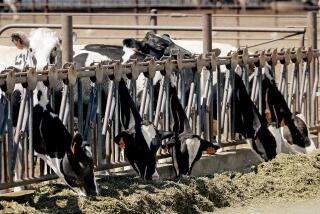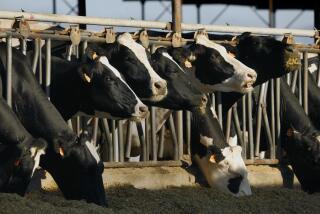Prop. 2 unlikely to hike egg prices
Californians voted resoundingly to free about 20 million egg-laying hens of tiny cages. But in passing Proposition 2, the farm animal welfare measure, did the state’s consumers yoke themselves to higher egg prices?
For months farmers had contended that the measure would drive up egg prices or even put them out of business because of the high cost of retrofitting their farms with cage-free facilities.
But the measure’s proponents and a respected state agriculture expert stressed Wednesday that such results were unlikely, especially in the short term. Proposition 2, approved by a nearly 2-to-1 margin, doesn’t take effect until 2015.
Also, California imports a third of the shelled eggs it consumes from out-of-state producers, which are not subject to the new regulations. There would be no reason for a jump in the price of those eggs, according to a study on the economic effects of the proposition from the UC Davis Agricultural Issues Center. Out-of-state producers would also be likely to increase their production to feed Californians.
“There is no reason to expect any significant change in the price of any eggs. That applies to eggs from cage-free hens too,” said Daniel Sumner, the primary author of the UC Davis study.
Eggs from cage-free hens generally cost at least 25% more than conventional eggs, according to the study. (Spotted on Monday at Whole Foods in Brentwood: the basic, Chino Valley Ranchers cage-free eggs for $2.39.)
But proponents and opponents, who each spent roughly $8.5 million on their campaigns, see different scenarios affecting mainly the $323-million California egg industry.
The measure bans confining crates and cages for hens, pregnant pigs and veal calves that don’t allow the animals to turn around, lie down and extend their limbs.
But because there are few veal producers here and the largest pork producer voluntarily eliminated crates, the measure affects mostly egg farmers, many of whom predict the demise of the state’s entire egg industry.
Egg farmers said it would be too costly to retrofit their farms. Sumner, a professor of agricultural economics, agrees.
“The alternative is to lose a million dollars a year,” he said. “Growing chickens isn’t like growing wine grapes. It’s not a romantic business. It doesn’t attract a lot of movie stars and Silicon Valley entrepreneurs.”
Ryan Armstrong, an egg farmer in Valley Center, Calif., became something of a spokesman on behalf of Californians for Safe Food, the group organized to fight the measure.
Armstrong, who with 600,000 birds considers himself a medium-size egg farmer, had predicted he would have to leave the state rather than convert to cage-free housing.
The state egg industry has been on the decline because of overall reduced egg consumption. On Wednesday, Armstrong sounded gloomy about his future.
“We haven’t quite figured it out. We’ll probably in the next month or so let some employees go and slim down our operations,” he said. “Our goal is probably not to stay in the egg business.”
Asked if he would have been downsizing his labor force whether the measure won or lost, Armstrong said no. “We’re going to have to cut birds and employees.”
He said it would cost roughly $30 a bird to create new housing. But even if he didn’t keep all his birds, it would still be too expensive, he said. “If I ask a banker today for $12 million, he would say don’t bother filling out the application,” he said.
The head of the Humane Society of the U.S., which sponsored the campaign, said farmers would adjust to meet an increasing demand for eggs from cage-free birds.
“For them to say, ‘We’re all going out of business because we have to let the birds stretch their wings,’ is absurd. That’s why the public rejected their argument,” said Wayne Pacelle, the group’s president.
Paul Shapiro, the Humane Society’s farm animal welfare expert, said that when pork and veal crates were phased out in Arizona, “the pork and veal producers made the same apocalyptic predictions.” But after Arizona voters passed the initiative, no pork producers left the state.
As the concept of treating farm animals humanely has become more accepted by the public, there has been an increase in demand for eggs from cage-free hens.
Restaurateur Wolfgang Puck said last year he would not use eggs from caged hens. Major chains that are using some cage-free hens’ eggs include Denny’s, Carl’s Jr. and Hardee’s. Numerous college and corporate cafeterias have switched to such eggs.
“Farmers are going to have to adjust their production strategies to accommodate this demand,” Pacelle said. “Over these next six years, the market for cage-free is expected to increase.”
Pacelle said the Humane Society was talking to egg producers in other states about changing their operations.
“It will force a lot of industrial farmers in other states to sit down and negotiate a phase-out because they don’t want to go through what the egg industry went through in this state,” he said. The egg industry spent “eight-and-a-half million bucks and they got a drubbing.”
--
jerry.hirsch@latimes.com
More to Read
Sign up for Essential California
The most important California stories and recommendations in your inbox every morning.
You may occasionally receive promotional content from the Los Angeles Times.












